Bulletin – March 2017 Payments How Australians Pay: New Survey Evidence
- Download 1.21MB
Abstract
The Reserve Bank's 2016 Consumer Payments Survey showed that Australian consumers are increasingly using their debit or credit cards instead of paying in cash or writing cheques. While more and more small payments are being made with contactless ‘tap and go’ cards, cash is still often used for lower-value transactions and accounts for a significant share of payments for some segments of the community.
Introduction
In November 2016, the Bank undertook its fourth triennial survey of consumer payments.[1] As in previous surveys, participants recorded details about every transaction they made for a week – including value, payment method, channel (e.g. online or in person) and type of merchant – and provided additional information on their payment preferences and attitudes in a post-survey questionnaire. Over 1,500 people participated in the 2016 survey, recording around 17,000 consumer payments (see ‘Box A: Details of the Survey’).
The survey showed that Australian consumers are continuing to switch to electronic payment methods in preference to paper-based methods – cash and cheques – for their transactions. Credit and debit cards combined were the most frequently used means of payment in the 2016 survey, overtaking cash (Table 1). Cards are increasingly being used for lower-value transactions, reflecting the adoption of contactless ‘tap and go’ functionality at the point of sale. Although the share of payments made in cash continued to fall, cash was still used for over one-third of consumer payments.
This article discusses key findings of the 2016 Consumer Payments Survey, focusing on: consumers' use and holdings of cash; trends in payment card use; and the use of personal cheques.[2]
Cash Use and Holdings
The trend decline in the share of consumer payments made in cash continued in 2016 – survey participants made 37 per cent of their payments in cash, compared with 47 per cent in 2013 and 69 per cent in 2007 (Graph 1, left panel).[3] The decline in the use of cash relative to other payment methods since the 2013 survey mainly reflects consumers switching to contactless cards for lower-value payments (Graph 2).[4] Nonetheless, cash was still frequently used for smaller transactions and was the most common payment method for transactions of $10 or less (accounting for over 60 per cent of these payments). The median size of a cash payment was $12, which was the same as in the 2013 survey. When measured by the value of payments (rather than the number), the share of cash transactions was steady, at around 18 per cent, reflecting a small number of large cash payments (Graph 1, right panel).
| 2007 | 2010 | 2013 | 2016 | |
|---|---|---|---|---|
| Cash | 69 | 62 | 47 | 37 |
| Debit, credit/charge cards | 26 | 31 | 43 | 52 |
| BPAY | 2 | 3 | 3 | 2 |
| Internet/phone banking | na | 2 | 2 | 1 |
| PayPal | na | 1 | 3 | 3 |
| Cheque | 1 | 1 | 0.4 | 0.2 |
| Other(b) | 1 | 1 | 2 | 4 |
|
(a) Excluding payments over $9,999 Sources: Colmar Brunton; Ipsos; RBA; Roy Morgan Research |
||||
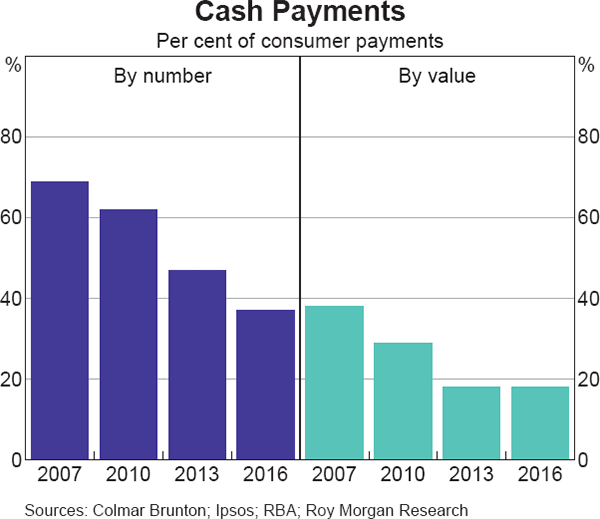
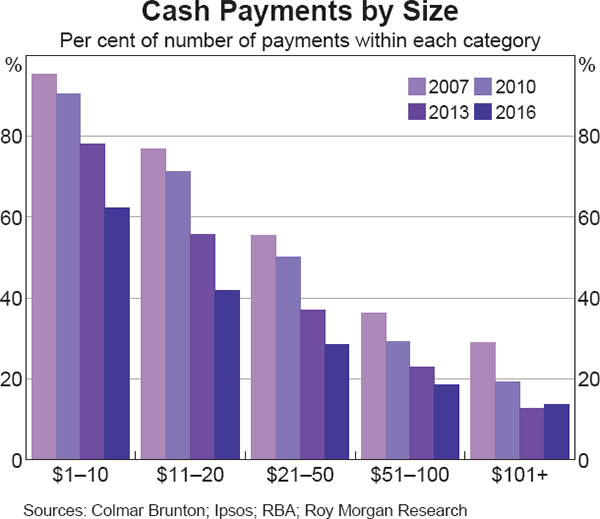
Although electronic payment methods have become more popular, some members of the community make a substantial share of their payments in cash, including older Australians and lower-income households (Graph 3).[5] While these demographic groups have not, on average, adopted electronic payments as quickly as the general population, they are nonetheless using cash for a smaller share of transactions than in the past. Older Australians, for example, are using electronic payment methods more frequently, as indicated by the ongoing decline in the share of payments made in cash by people aged 65 and over – from 78 per cent in the 2007 survey to 51 per cent in 2016.[6]
People continue to use cash at the point of sale for a variety of reasons. When asked about the most important reason for using cash for their transactions, survey participants in 2016 cited factors mainly relating to:
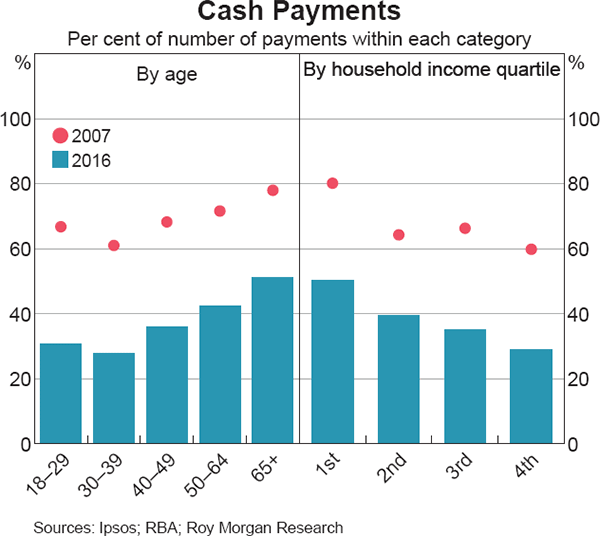
- Merchant acceptance, fees and pricing. The most common reason for using cash, cited by 19 per cent of respondents, was that merchants did not accept alternative payment methods or had minimum spend requirements. A further 16 per cent of participants cited a desire to avoid card surcharges, while 7 per cent cited discounts for cash use (Graph 4).
- Consumer preferences and habits. Respondents indicated a preference for using cash in small transactions (18 per cent of respondents) and a preference for using their own funds and to use cash as a budgeting tool (14 per cent). A smaller share indicated that fraud and privacy concerns were their most important reasons for using cash. For those participants who used cash most intensively, consumer preferences were more important than factors relating to merchant acceptance.
Consistent with the decline in transactional use of cash, the median value of cash held in consumers' wallets fell to $40, from $55 in 2013.[7] The main reason for holding cash, other than for day-to-day transactions, was for precautionary purposes (i.e. to fund emergency transactions). But there was a wide dispersion across participants in the amount of cash that they carried – for example, around one-fifth of respondents were not holding any cash in their wallets at the beginning of the survey week (compared with 8 per cent in 2013).
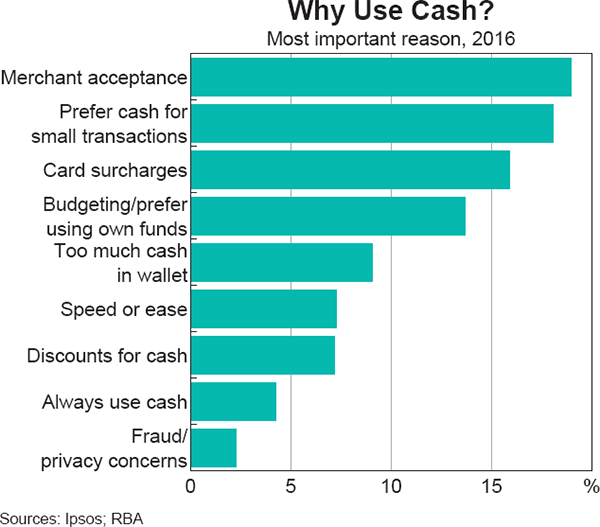
The survey also asked people about the cash they usually hold in places other than their wallets. In 2016, around 70 per cent of survey participants reported holding some cash outside of their wallet, compared with about 75 per cent in 2013. While the majority of participants held $100 or less, around 3 per cent reported that they held over $1,000. As with cash held in wallets, the most common reason for holding cash elsewhere was for emergency transaction needs (Graph 5). A smaller but still significant share of respondents (26 per cent) cited issues relating to the accessibility of cash – ATM fees and access, and withdrawal time – as their most important reasons for holding cash outside their wallet.
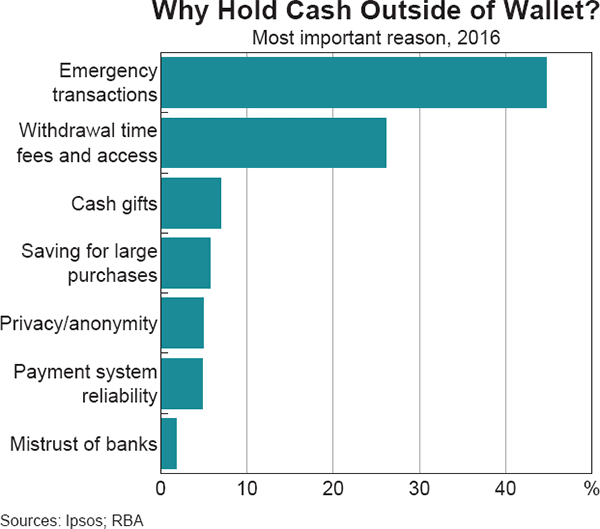
Payment Cards
As the decline in transactional use of cash has continued, there has been a rise in the share of card payments. Between 2013 and 2016, the share of payments (by number) made using credit and debit cards increased by 9 percentage points to 52 per cent.[8] The recent increase in the frequency of card use relative to other payment methods was almost entirely because cards were used more often for in-person payments; card use for online payments barely increased as a share of total payments in the 2016 survey (and the share of total payments made online was stable, Table 2).
Between 2013 and 2016, growth in the relative use of cards was strongest for lower-value transactions, with consumers increasingly using debit (and to a lesser extent credit) cards for payments of $20 or less (Graph 6). Cards are now the most commonly used payment method for all but the lowest-value transactions (i.e. those of $10 or less). As a result, the median value of card payments at the point of sale continued to decline, from $40 in 2007 to $28 in 2016. The use of cards for lower-value payments has been facilitated by the rapid adoption of contactless functionality by consumers and merchants in recent years. Around one-third of all point-of-sale transactions were conducted using contactless cards in 2016, which is 3½ times the share reported by participants in the 2013 survey (Graph 7).
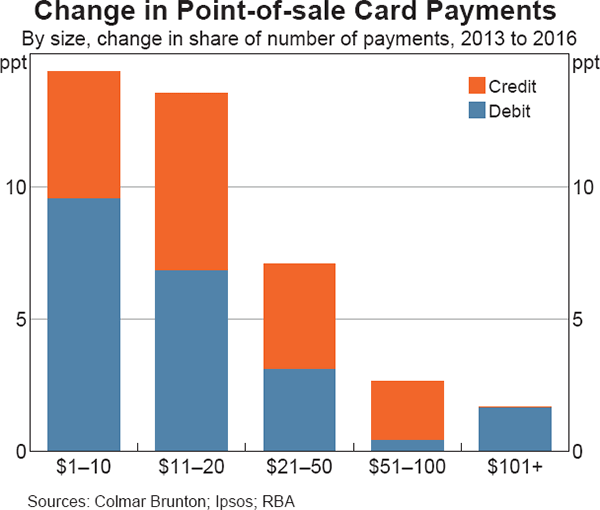
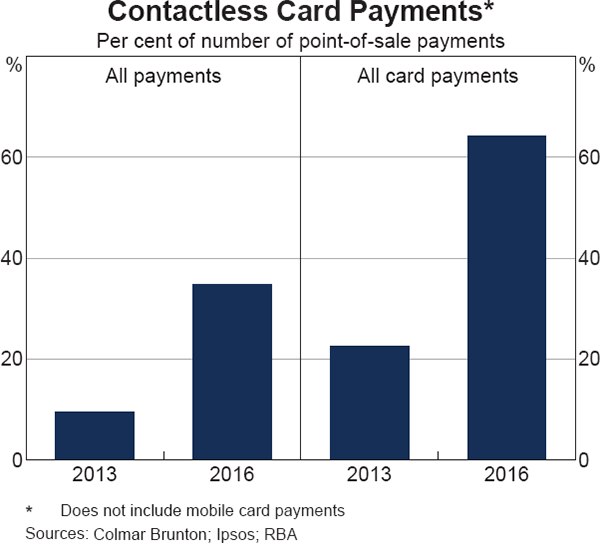
The 2016 survey provided some preliminary insights into the use of mobile devices to make card payments at the point of sale (mobile payments). These payments are made by tapping or waving a smartphone or other mobile device in front of a card terminal rather than using a physical (plastic) card.[9] The ability to make mobile payments – whether provided via third-party mobile wallets or banks' proprietary banking applications – is a relatively new feature of the payments landscape (and is not yet available across all payment schemes and card issuers). Consistent with this, mobile payments accounted for only around 1 per cent of the number of point-of-sale transactions over the week of the survey (around 2 per cent of in-person card payments). The users of mobile payments were spread across a range of age groups and tended to have above-average incomes (Graph 8). Many respondents who did not use mobile payments indicated that they were, at this stage, satisfied with their current payment methods.
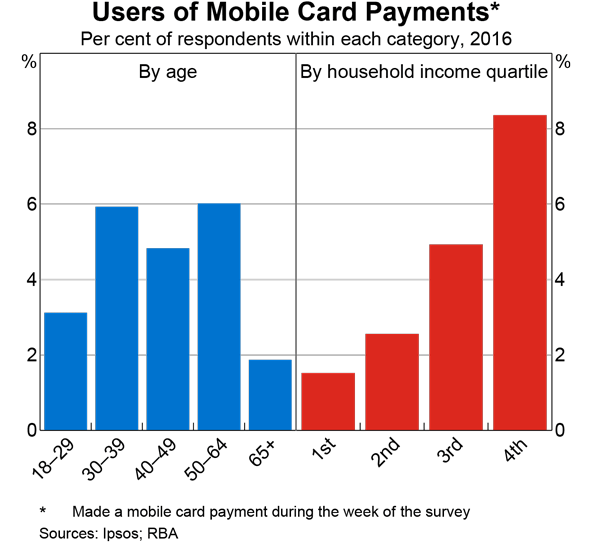
| 2013 | 2016 | |
|---|---|---|
| In-person payments | 86 | 86 |
| of which: card payments | 37 | 45 |
| Online payments | 13 | 13 |
| of which: card payments | 5 | 6 |
| Telephone/mail payments | 1 | 1 |
|
Sources: Colmar Brunton; Ipsos; RBA |
||
Personal Cheques
The use of personal cheques continued to decline, with cheques accounting for only 0.2 per cent of payments made by participants in the 2016 survey, compared with 0.4 per cent in 2013 and 1.2 per cent in 2007. However, 12 per cent of respondents said they had made at least one personal cheque payment in the year prior to the survey (down from around 20 per cent in 2013). The latest survey results provide further evidence of the long-term decline in the use of cheques.[10] Cheque use remains concentrated among older Australians; around 70 per cent of the small number of cheque payments recorded in the 2016 survey were made by participants aged 65 and over. Nonetheless, fewer cheques are being written by consumers of all ages (Graph 9).
As in previous surveys, personal cheques were mainly used for larger expenditures such as household services, bills or holidays. Accordingly, cheque payments have a higher median value ($135) than cash or card payments. For the most part, those households that continue to use cheques report that they do so because some merchants prefer to be paid by cheque, there is no alternative for that particular type of payment or because cheques provide a useful record of the payment (Graph 10). Those respondents also value the safety of cheque payments and that cheques allow them to include more information with the payment (by attaching documents).
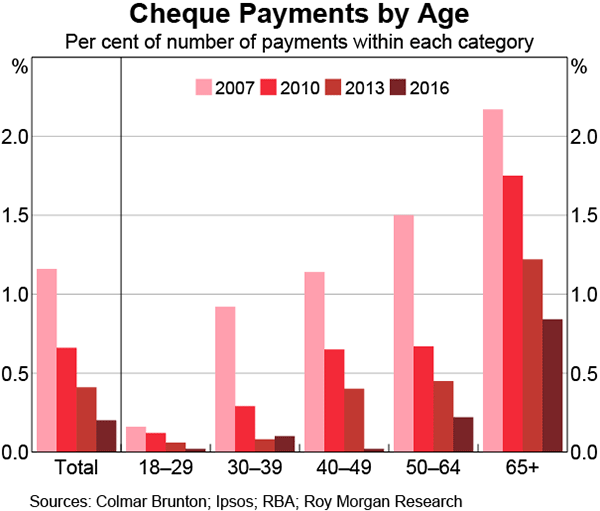
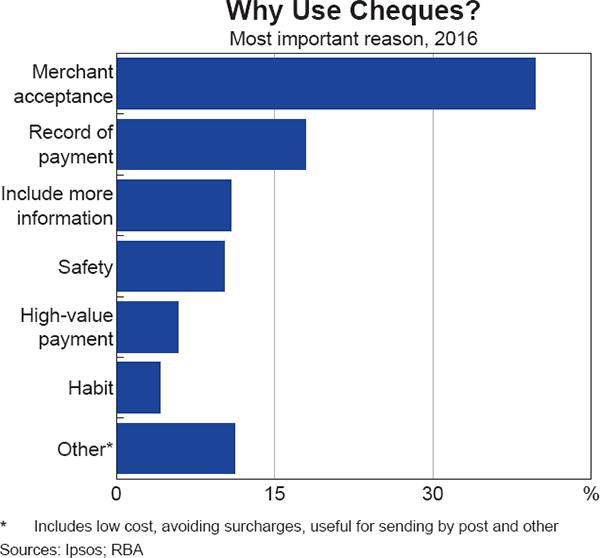
Conclusion
The Australian payments system is evolving. The Bank's 2016 Consumer Payments Survey showed that consumers are continuing to shift away from paper-based payment methods towards electronic means of payment, particularly cards. It would not be surprising if these trends continue, as electronic payment methods are increasingly adopted and new payment methods emerge. For instance, the New Payments Platform (NPP) – which is due to be launched late this year – may provide additional convenient electronic alternatives to cheques, and also to cash in some circumstances (e.g. person-to-person payments).[11] An assessment of the ability of the NPP to meet the demands of cheque users is likely to inform industry discussions about the future of the cheque system.[12] Although a smaller share of consumer payments are being made in cash than in the past, the 2016 survey indicated that cash remains an important part of the economy and payments system. Cash is still used for a significant share of consumer payments, is heavily relied on by some members of the community and is widely held as a store of value.
Box A
Details of the Survey
The fieldwork for the 2016 Consumer Payments Survey was conducted by the research firm Ipsos on behalf of the Bank in November 2016. The survey consisted of three parts: a pre-diary questionnaire about the demographic characteristics of respondents; a seven-day payments diary; and a post-survey questionnaire about respondents' payment preferences and attitudes. To encourage participation and engagement with the survey, respondents received a gift card on completion of the three components.
The survey was delivered online for most respondents but to ensure the sample was broadly representative of the Australian population, participants without internet access were recruited by telephone to complete a paper-based survey. The overall response rate was good, and broadly in line with the 2013 survey, resulting in a final sample of just over 1,500 respondents.
In addition to household internet access, recruitment targets for age, sex, household income, credit card ownership and location (i.e. capital city or regional area) were set so that the sample would be reasonably representative of the Australian population.[1] To account for different response rates across the various demographic categories, the Bank weighted the responses so that the final sample aligned with Australian Bureau of Statistics population benchmarks.
Footnotes
The authors are from Payments Policy Department. [*]
The research firm Ipsos conducted the 2016 survey on behalf of the Bank. The Bank has undertaken a consumer payments survey every three years since 2007. See Emery, West and Massey (2008); Bagnall, Chong and Smith (2011); and Ossolinski, Lam and Emery (2014). [1]
A detailed report will be published later in the year. [2]
See Meredith, Kenney and Hatzvi (2014) and Davies et al (2016) for detailed discussions of cash use. [3]
Between 2010 and 2013, contactless cards also appeared to displace cash and, to a lesser extent, PIN-authenticated card transactions at the point of sale. [4]
Around 12 per cent of all 2016 survey participants reported that they used cash for all of their in-person transactions, a similar share to the 2013 survey. [5]
These figures will capture both the effect of a change in the composition of age cohorts and a shift away from cash by older Australians. [6]
The average value of cash holdings was little changed from 2013, reflecting the fact that a small number of participants in the 2016 survey reported that they carried a large amount of cash in their wallets. [7]
In this article, references to ‘payment cards’ or ‘cards’ generally refers to debit, credit and charge cards. In the 2016 survey, gift/prepaid cards were separately identified for the first time. However, for comparability with previous surveys, gift/prepaid cards have been included in the ‘other’ payment method category. These cards accounted for around 2 per cent of consumer payments in 2016. [8]
The physical card details are typically stored (provisioned) in a digital ‘wallet’ application on the mobile device, which is equipped with contactless functionality similar to contactless physical cards. [9]
See Richards (2016) for a discussion of the cheque system. [10]
The NPP will allow individuals and businesses to make account-toaccount funds transfers in real time, at any time of the day or night, seven days a week. It will also allow for end users to attach data or documents to payments. For more details see Bolt, Emery and Harrigan (2014). [11]
For more details see Australian Payments Council (2015). [12]
Footnote Box A
Recruitment targets for most demographic variables were based on data from the Australian Bureau of Statistics. [1]
References
Australian Payments Council (2015), ‘Australian Payments Plan’, December.
Bagnall J, S Chong and K Smith (2011), Strategic Review of Innovation in the Payments System: Results of the Reserve Bank of Australia's 2010 Consumer Payments Use Study, Sydney.
Bolt S, D Emery and P Harrigan (2014), ‘Fast Retail Payment Systems’, RBA Bulletin, December, pp 43–51.
Davies C, M Doyle, C Fisher and S Nightingale (2016), ‘The Future of Cash’, RBA Bulletin, December, pp 43–52.
Emery D, T West and D Massey (2008), ‘Household Payment Patterns in Australia’, in Payments System Review Conference, Proceedings of a Conference, Reserve Bank of Australia, Sydney, pp 139–176.
Meredith J, R Kenney and E Hatzvi (2014), ‘Cash Use in Australia’, RBA Bulletin, June, pp 43–54.
Ossolinski C, T Lam and D Emery (2014), ‘The Changing Way We Pay: Trends in Consumer Payments’, RBA Research Discussion Paper No 2014-05.
Richards T (2016), ‘The Ongoing Evolution of the Australian Payments System’, Speech at Payments Innovation 2016 Conference, Sydney, 23 February.